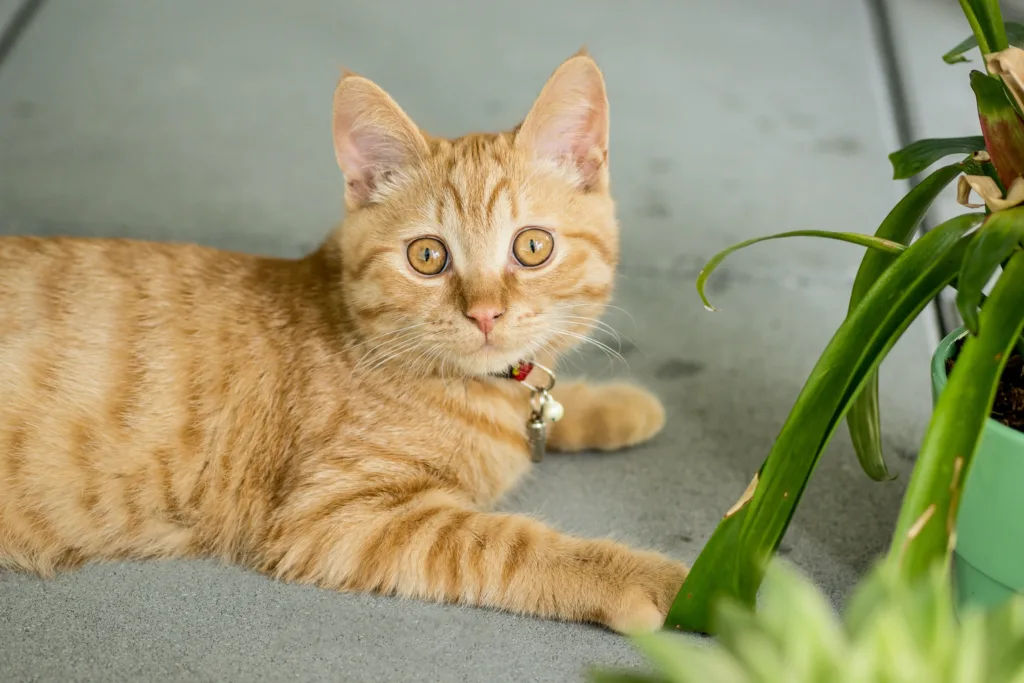Spider plants (Chlorophytum comosum) are not generally considered highly toxic to cats, but they do contain compounds that can be irritating or cause mild gastrointestinal upset if ingested.
The plant contains chemical compounds such as saponins, which, when consumed in larger quantities, may lead to symptoms like vomiting or diarrhea in cats.
It’s important to note that individual reactions can vary, and some cats may be more sensitive to certain plants than others. If you suspect your cat has ingested any part of a spider plant and displays symptoms of illness, it’s advisable to contact your veterinarian for guidance.
To minimize the risk of ingestion:
- Place the Plant Out of Reach: Keep spider plants in locations that are difficult for cats to access, such as hanging baskets or shelves.
- Provide Alternative Greens: Offer cat-friendly grasses or catnip as alternatives to deter them from chewing on the spider plant.
- Monitor Your Cat: If you have a spider plant in your home and your cat shows interest in it, closely monitor their behavior. If you notice any signs of illness, contact your veterinarian.
Always consult with your veterinarian if you have concerns about specific plants or if your cat shows signs of poisoning. Additionally, consider having a list of plants that are toxic to cats and ensuring that your indoor environment is safe for your feline companions.
Why Do Cats Like Spider Plants?
Cats are often attracted to spider plants (Chlorophytum comosum) for a variety of reasons:
- Texture: The long, arching leaves of spider plants have a unique texture that some cats find appealing for chewing and batting.
- Movement: The leaves of spider plants often move with air currents or when touched, and this movement can capture a cat’s attention and stimulate their natural hunting instincts.
- Visual Appeal: The green color and the arrangement of the spiderettes (small plantlets that form on the ends of long stems) can be visually interesting to cats, prompting them to investigate.
- Curiosity: Cats are naturally curious creatures, and anything new or different in their environment may attract their attention.
- Chewing Behavior: Chewing on plants is a common behavior in cats. It may be a form of exploration, play, or even an attempt to address dietary needs, such as getting more fiber in their diet.

However, it’s important to note that while spider plants are generally considered non-toxic to cats, the plants do contain compounds that can cause mild gastrointestinal upset if ingested in large quantities. To ensure your cat’s safety:
- Monitor their Behavior: If your cat shows a strong interest in the spider plant, monitor their behavior and discourage excessive chewing.
- Provide Alternatives: Offer cat-friendly grasses or toys designed for chewing to redirect their attention.
- Place Plants Out of Reach: Consider placing the spider plant in an area that is difficult for your cat to access, such as hanging it or putting it on a shelf.
Always be aware of the specific needs and behaviors of your individual cat, and consult with your veterinarian if you have concerns about your cat’s interactions with specific plants.
People Also Ask
- What happens if a cat eats a spider plant?
- Spider plants are considered non-toxic to cats, but they contain compounds that may cause mild gastrointestinal upset if ingested in larger quantities. Symptoms may include vomiting or diarrhea. If you suspect your cat has ingested a significant amount and shows signs of illness, consult your veterinarian.
- Are spider plants pet-friendly?
- Spider plants are generally considered safe for pets, including cats. While they may cause mild digestive issues if ingested in large amounts, they are not highly toxic. However, individual reactions can vary, and it’s advisable to monitor your pet’s behavior and contact a vet if any concerns arise.
- Are spider mums toxic to cats?
- Spider mums (Chrysanthemum) can be toxic to cats. They contain compounds called pyrethrins that may cause symptoms such as vomiting, diarrhea, hypersalivation, and, in severe cases, tremors or seizures. It’s best to keep spider mums out of reach of pets.
- Is the spider plant an indoor plant?
- Yes, the spider plant (Chlorophytum comosum) is commonly grown as an indoor plant. It is well-suited for indoor environments and is known for its arching leaves and spiderettes. However, care should be taken to keep it out of reach of pets if they show a strong interest in chewing on the leaves.

